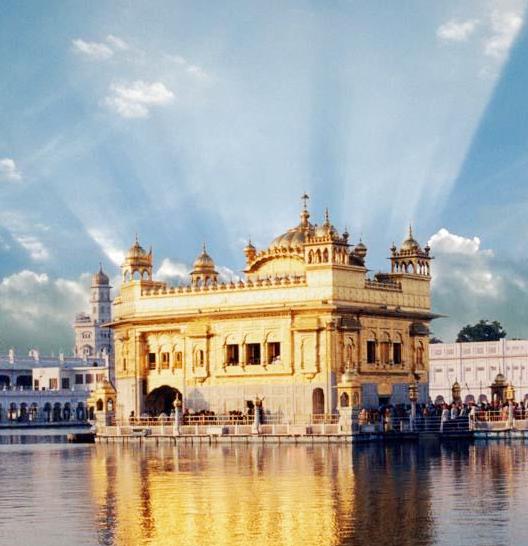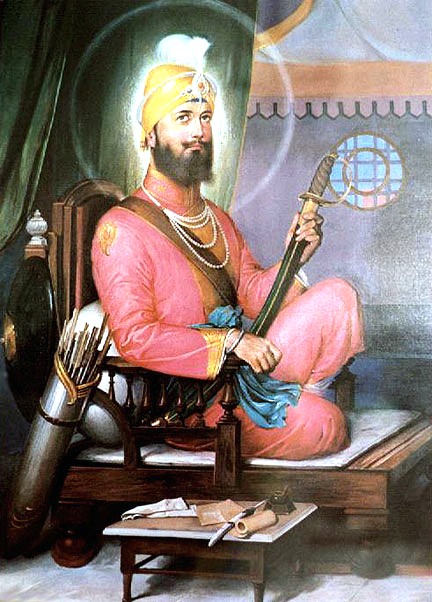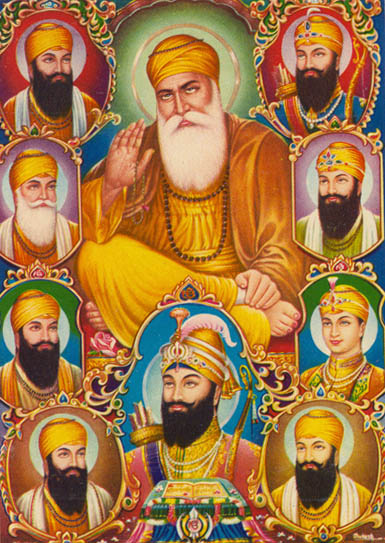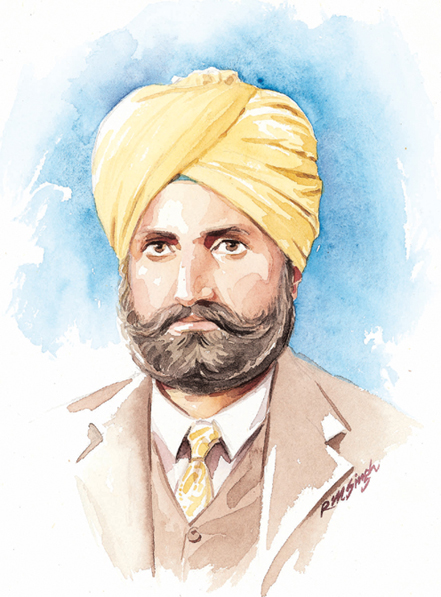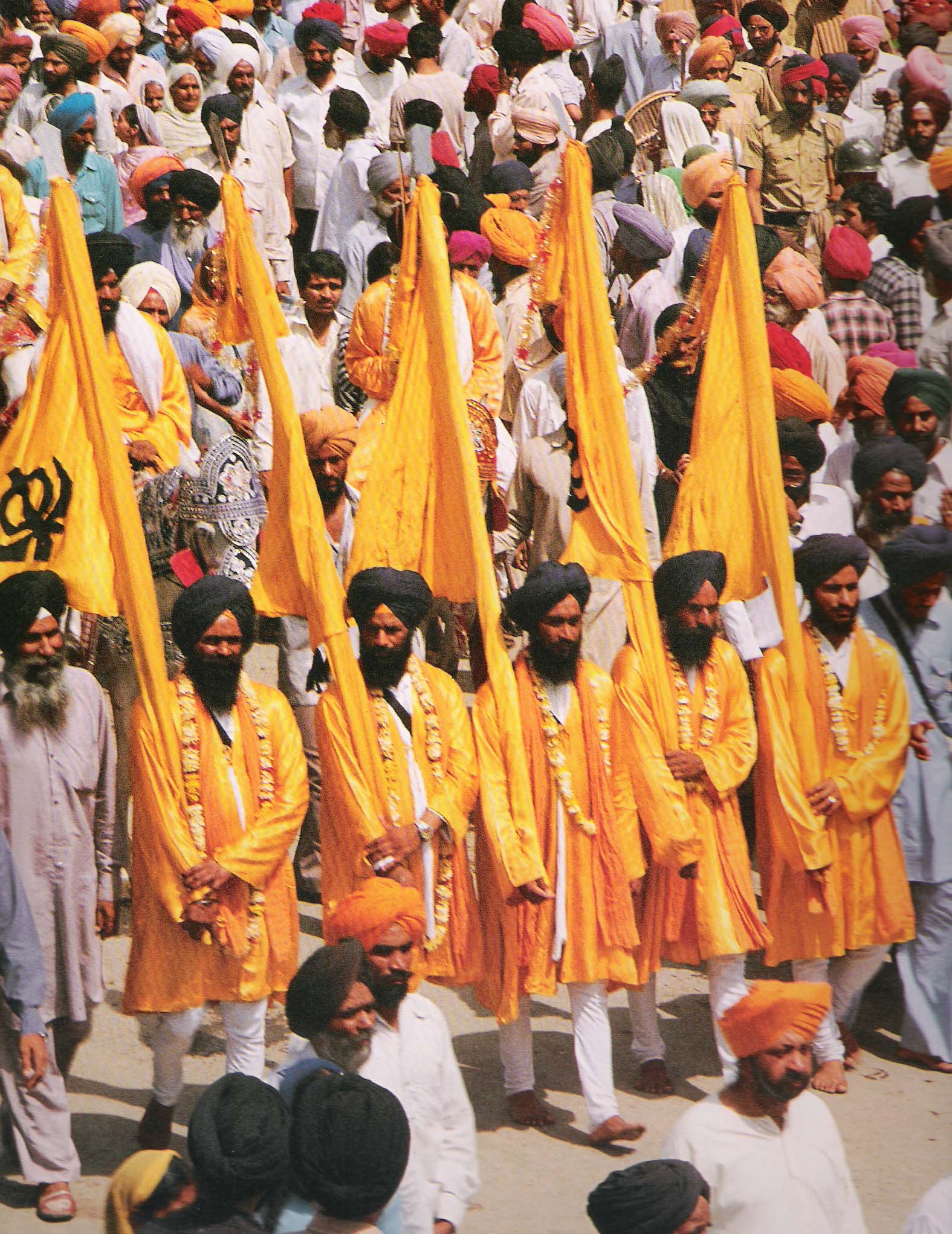Sikhi
| Part of a series on Sikhism |
|
|
Sikhi,(Gurmukhi: ਸਿੱਖੀ ), amongst the youngest of the major world religions, originated and primarily developed in the 15th-17th century sub-continental India (South Asia). The word Sikhi derives from the word Sikh, which itself is based on the Sanskrit root "śiṣya" (शिष्यः), meaning a "disciple" or "learner". Guru Nanak Dev Ji was the founder of Sikhi. He was born in 1469 in the village of Nankana Sahib, near Lahore in present-day Pakistan. The faith system is based on the teachings of Guru Nanak Dev Ji and ten successive Sikh Gurus (divine messengers or enlighteners), with the last one being the revealed sacred scripture, Guru Granth Sahib. This system of religious philosophy and expression has been traditionally known as Gurmat (literally the counsel of the Gurus) or the Sikh Dharma. With around 30 million followers worldwide, Sikhism is the fifth largest organized religion in the world.
The principal belief of Sikhism is faith in waheguru — represented using the sacred symbol of ik ŝaṅkĝr, the Universal God. Sikhism advocates the pursuit of salvation through disciplined, personal meditation on the name and message of God. A key distinctive feature of Sikhism is a non-anthropomorphic concept of God, to the extent that one can interpret God as the entire creation itself.
The followers of Sikhism, or Sikhs, are ordained to follow the teachings of the ten Sikh Gurus, enshrined in the holy scripture the Guru Granth Sahib. While compiling the scripture, the fifth Sikh Guru, Guru Arjan Dev Ji incorporated not only the writings of the Sikh Gurus, but also included selected works of many devotees and saints from diverse socio-economic and religious backgrounds, who believed in the unity of God and denounced caste and superstition. The text was decreed by Guru Gobind Singh Ji, the tenth and last human guru, as the final guru of the Khalsa Panth.
Sikhism's traditions and teachings are distinctively associated with the history, society and culture of the Punjab region, the traditional homeland of the Sikhs and the site of the Sikh Empire. Presently, a majority of the Sikhs live in Punjab, India, and until India's partition in 1947, millions of Sikhs had lived in what is now Pakistani Punjab.
Besides Sikhi and Gurmat, Sikhism is also referred to as Aad-Matt (the primal counsel).
Core Beliefs
The core beliefs of Sikhism are:
Belief in one God
The belief in one pantheistic God. The opening sentence of the Sikh scriptures is only two words long, and reflects the base belief of all who adhere to the teachings of the religion: Ek Onkar "Ek" is One and "Onkar" is God - "There is only one God."
The Teachings of the Sikh Gurus
The teachings of the Ten Sikh Gurus (as well as other selected Muslim and Hindu saints and scholars) are enshrined in the Guru Granth Sahib. These teachings propagate the following values:
- to see God in everyone; understand and practice equality among all races irrespective of caste, religion, colour, status, age, gender, etc;
- to remember God at all times; to always engage in Simran or "remembrance of God", the primal being; virtuous, merciful, bountiful, fearless and Creator of everything; be always aware of His persona and behave accordingly;
- to value and respect positive ideals like truth, compassion, contentment, humility, love, etc; (a reflection of God-like features)
- to suppress the inner evils lust, anger/rage, greed, material attachment, ego, etc; (a reflection of anti-God features)
- to aspire and engage in useful, productive, honest and peaceful life of a householder; to work diligently while holding the image of God within you; (Kirit Karni)
- to engage in selfless service (Sewa) and help build a loving community life; to be a contributor to society whenever possible; (Wand kay shakna)
- to be ready to protect and stand for the rights of the weak among us; to fight for justice and fairness for all;
- to always accept the Will of God, (Hukam) and stay focused and in "Positive Spirits" (Chardikala), etc.
History of Sikhism
- Main article: History of Sikhism
Guru Nanak Dev (1469-1538), the founder of Sikhism, was born in the village of Talwandi, now called Nankana Sahib, near Lahore in present-day Pakistan. His father, Mehta Kalu was a Patwari- an accountant of land revenue in the government. Guru's mother was Mata Tripta and he had one older sister, Bibi Nanki. From the very childhood, Bibi Nanki saw in him the Light of God but she did not reveal this secret to anyone. She is known as the first disciple of Guru Nanak. Even as a boy, Nanak was fascinated by religion, and his desire to explore the mysteries of life eventually led him to leave home. He wandered all over India in the manner of Hindu saints. It was during this period that Nanak met Kabir (1441-1518), a saint revered by both Hindus and Muslims. He made four distinct major journeys, which are called Udasis spanning many thousands of miles.
In 1538, Guru Nanak chose Bhai Lehna, his disciple as a successor to the Guruship rather than his son. Bhai Lehna was renamed Guru Angad and became the second guru of the Sikhs. He continued the work started by Guru Nanak. Guru Amar Das became the third Sikh guru in 1552 at the age of 73. Goindwal became an important centre for Sikhism during the Guruship of Guru Amar Das. He continued to preach the principle of equality for women, the prohibition of Sati and the practise of Langar. In 1567, Emperor Akbar sat with the ordinary and poor people of Punjab to have Langar. Guru Amar Das also trained 140 apostles of which 52 were women to manage the rapid expansion of the religion. Before he died in 1574 aged 95, he appointed his son-in-law, Jetha as the fourth Sikh Guru.
Jetha became Guru Ram Das and vigorously undertook his duties as the new guru. He is responsible for the establishment of the city of Ramdaspur later to be named Amritsar. In 1581, Guru Arjan- youngest son of fourth guru - became the Fifth Guru of the Sikhs. In addition to being responsible for the construction of the Golden Temple, he prepared the Sikh Sacred text and his personal addition of some 2,000 plus hymns in the Guru Granth Sahib. In 1604 he installed the Adi Granth for the first time as the Holy Book of the Sikhs. In 1606, he was arrested and fined an enormous sum, by the newly installed Mughal Emperor Jahangir, which he refused to pay. His followers and a highly respected friend the Sufi Sant Hazrat Mian Mir attempted to intercede on his behalf, but believing he had done nothing to warrant the fine he told them he wanted no one to interfere with the workings of Waheguru. He was also asked to change some wording of the former Gurus which he had collected in the Adi Granth--this he refused to do. He was tortured severely and finally allowed to bath in the nearby river. His followers and admirers watched as he walked on his badly burned and blistered feet to the river's edge, waded in and then disappeared under the water never to be seen again, becoming the first Martyr of the Sikhs.
Guru Hargobind, became the sixth guru of the Sikhs. He carried two swords; one for Spiritual reasons and one for temporal (worldly) reasons. From this point onward, the Sikhs became a military force and always had a trained fighting force to defend their independence. In 1644, Guru Har Rai became Guru followed by Guru Har Krishan, the boy Guru in 1661. Guru Teg Bahadur became Guru in 1665 and led the Sikhs until 1675, when he sacrificed his life in defense the Kashmiri Hindus who had come to him for help.
In 1675, Aurangzeb ordered the public execution of the ninth Sikh Guru, Guru Tegh Bahadur. Sikh mythos (above) says that Guru Tegh Bahadur sacrificed himself to save Hindus, after Kashmiri pandits came to him for help when the Emperor condemned them for failing to convert to Islam. This marked a turning point for Sikhism. His successor, his son Guru Gobind Rai further militarised his followers (see Khalsa). After the treachery of his neighboring Hill chieftains (Katri Rajputs who he had expected to join him in expelling or at least putting an end to the Mughal tyranny and forced conversions of Hindus) who took the side of the Mughals and tricked him and the Sikhs, under a guarantee of safe passage, into abandoning Anandpur, many of his Sikhs including his four sons and his mother, Gobind Singh on reaching safety sent Aurangzeb a letter known as the Zafarnama (Epistle of Victory).
Shortly before passing away Guru Gobind ordered that Guru Granth Sahib, the Sikh Holy Scripture, would replace the line of human Gurus and become the spiritual authority for the Sikhs and placed the temporal authority with the Khalsa Panth; the Sikhs themselves.
The first Sikh Holy Scripture was compiled and edited by the Fifth Guru, Guru Arjan in 1604, although some of the earlier gurus are also known to have documented their revelations. This is one of the few scriptures in the world that has been compiled by the founders of a faith during their own life time. The Guru Granth Sahib is particularly unique among sacred texts in that it is written in Gurmukhi script but contains many languages including Punjabi, Hindi-Urdu, Sanskrit, Bhojpuri and Persian. Sikhs consider the Guru Granth Sahib the last, perpetual living guru.
The Gurus of Sikhism
The Ten Gurus of Sikhism
Sikhism was established by ten Gurus; teachers or masters; over the period 1469 to 1708. These teachers were enlightened souls whose main purpose in life was the spiritual and moral well-being of the masses. Each master added to and reinforced the message taught by the previous, resulting to the creation of the religion of Sikhism. Guru Nanak was the first Guru and Guru Gobind Singh the final Guru in human form. When Guru Gobind Singh left this world, he made the Sri Guru Granth Sahib the ultimate and final Sikh Guru.
The Sri Guru Granth Sahib

- Main article: Guru Granth Sahib
The Guru Granth Sahib is a sacred text considered by Sikhs to be their eleventh and final Guru. Sikhism was influenced by reform movements in Hinduism (e.g. Bhakti, monism, Vedic metaphysics, guru ideal, and bhajans) as well as Sufi Islam. It departs from some of the social traditions and structure of Hinduism and Islam (such as the caste system and purdah, respectively). Sikh philosophy is characterised by logic, comprehensiveness, and a "without frills" approach to both spiritual and material concerns. Its theology is marked by simplicity. In Sikh ethics there is no conflict between an individual’s duty to oneself and that towards society.
The Guru Granth Sahib is the eleventh and final Guru of the Sikhs, is held in the highest regard by the Sikhs and is treated as the Eternal Guru, as instructed by Guru Gobind Singh.
It is perhaps the only scripture of its kind which not only contains the teachings of its own religious founders but also writings of people from other faiths. Besides the Banis of the Gurus, it also contains the writings of saints like Kabir, Namdev, Ravidas, Sheikh Farid, Trilochan, Dhanna, Beni, Sheikh Bhikan, Jaidev, Surdas, Parmanad, Pipa and Ramanand.
The Granth forms the central part of the Sikh place of worship called a gurdwara. The Holy Scripture is placed on the dominant platform in the main hall of the gurdwara during the day. It is placed with great respect and dignity upon a throne with beautiful and colourful fabric.
Sikh religious philosophy
- Main article: Sikh religious philosophy
The Sikh religious philosophy can be divided into the following five sections:
Primary beliefs and principles

- Main article: Sikhism primary beliefs and principles
Sikhism advocates the belief in one pantheistic God (Ek Onkar) who is omnipresent and has infinite qualities. Sikhs do not have a gender for God nor do they believe God takes a human form. All human beings are considered equal regardless of their religion, sex or race. All are sons and daughters of Waheguru, the Almighty.
Followers of Sikhism are encouraged to wake in the early morning hours, before the sun has risen, and meditate on God's name. They must work hard and honestly and never live off of others, but give to others from the fruits of one's own labour. A Sikh's home should always be open to all.
Sikhs believe in the concept of reincarnation. All creatures are believed to have souls that pass to other bodies upon death until liberation is achieved. Sikhs should defend, safeguard, and fight for the rights of all creatures, and in particular fellow human beings. They are encouraged to have a "Chardi Kala" or positive, optimistic and buoyant view of life.
The Sikh religion is not considered the only way to salvation - people of other religions may also achieve salvation. This concept is shared with other religions.
Upon baptism, Sikhs must wear the 5Ks, strictly recite the 5 prayers. Sikhs do not believe that any particular day is holier than any other and general adopt the religous day of the country within which they reside.
It is every Sikh's duty to defeat these five vices: ego, anger, greed, attachment, and lust in his/her being with contentment, charity, kindness, positive attitude and humility.
Underlying values
- Main article: Sikhism underlying values
The Sikhs must believe in the following values:
- Equality: All humans are equal before God.
- God's spirit: All creatures have God's spirits and must be properly respected.
- Personal right: Every person has a right to life but this right is restricted.
- Actions count: Salvation is obtained by one's actions, including good deeds, remembrance of God, etc.
- Living a family life: Must live as a family unit to provide and nurture children.
- Sharing: It is encouraged to share and give to charity 10 percent of one's net earnings.
- Accept God's will: Develop your personality so that you recognize happy events and miserable events as one.
- The four fruits of life: Truth, contentment, contemplation and Naam, (in the name of God).
Prohibited behavior
- Main article: Sikhism prohibited behavior
- Non-logical behavior: Superstitions and rituals are not meaningful to Sikhs (pilgrimages, fasting, bathing in rivers, circumcision, worship of graves, idols or pictures, compulsory wearing of the veil for women, etc.).
- Material obsession: ("Maya") Accumulation of materials has no meaning in Sikhism. Wealth such as gold, portfolio, stocks, commodities, and properties will all be left here on Earth when you depart. Do not get attached to them.
- Sacrifice of creatures: (Sati). Widows throwing themselves in the funeral pyre of their husbands, lamb and calf slaughter to celebrate holy occasions, etc. are forbidden.
- Non-family oriented living: A Sikh is not allowed to live as a recluse, beggar, yogi, monk, nun, or celibate.
- Worthless talk: Bragging, gossip, lying, etc. are not permitted.
- Intoxication: Alcohol, drugs, tobacco, and consumption of other intoxicants is not permitted.
- Priestly class: Sikhs do not have to depend on a priest for performing any religious functions. They are not supposed to follow a class/caste system where the priestly class reigns highest. Everyone is equal.
Technique and methods
- Main article: Sikhism technique and methods
- Naam Japo: - Free service (Sewa), meditation and prayer (Simran), sacred music (Kirtan).
- Kirat Karni: - Honest earnings, labor, etc. while remembering the Lord.
- Wand kay Shako: - Share with others in need, free food (langar), donate 10% of income Daasvand, etc.
Other observations
- Main article: Sikhism other observations
| Sikhi & Other Religons |
|
♣♣ Islam ♣♣ Hindu Dharam ♣♣ Christianity ♣♣ Jain Dharam ♣♣ Dhamma ♣♣ Judaism ♣♣ |
- Not son of God: The Gurus were not in the Christian sense “Sons of God”. Sikhism says all humans are the children of God and by deduction, God is mother/father.
- All are welcome: Members of all religions may visit Sikh temples (Gurdwaras), but must observe certain rules: cover the head, remove shoes, no smoking or drinking intoxicants inside, and visitors must not be under the influence of any drugs, especially alcohol.
- Multi-level approach: Sikhism recognises the concept of a multi-level approach to achieving one's target as a disciple of the faith. For example, "Sahajdhari" (slow adopters) are Sikhs who have not donned the full 5Ks but are still Sikhs nevertheless.
Note: The Punjabi language does not have a gender for God. Unfortunately, when translating, the proper meaning cannot be correctly conveyed without using Him/His/He/Brotherhood, S/He etc., but this distorts the meaning by giving the impression that God is masculine, which is not the message in the original script. The reader must correct for this every time these words are used.
Sikhs today
Today, Sikhs can be found all over India and elsewhere in the world. Sikh men as well as some Sikh women can be identified by their practice of always wearing a turban to cover their long hair. The turban is quite different from the ones worn by the Muslim clergy and should not be confused with them. The surname or more usually the middle name Singh1 (meaning lion) is very common for males, and Kaur (meaning princess) for women. Of course, not all people named Singh or Kaur are necessarily Sikhs, the Sikhs adopted the name Singh in 1699 during the Birth of the Khalsa. The name Singh is closely linked to the martial antiquities of North India dating back to at least the Eighth Century CE.
The Five Ks
- Main article: The Five Ks
Practicing Sikhs are bound to wear five items, known as The Five Ks, at all times. It is done either out of respect for the tenth Sikh Guru, Guru Gobind Singh, or out of sense of duty or from understanding of their function and purpose and relevance in daily life. It is important to note that The Five Ks are not merely present for symbolic purposes. The tenth Guru, Guru Gobind Singh, ordered these Five Ks to be worn so that a Sikh could actively use them to make a difference to their own spirituality and to others' spirituality.
The 5 items are: Kesh (uncut hair), Kanga (small comb), Kara (circular bracelet), Kirpan (small sword) and Kacha (shorts).
Sikhs around the world
A Sikh known as Yogi Bhajan brought the Sikh way of life to many young people in the Western hemisphere. In addition to Indian-born Sikhs, there are now thousands of individuals of Western origin who were not born as Sikhs, but have embraced the Sikh way of life and live and teach all over the world.
In the late 1970s and 1980s a limited political separatist movement arose in India with the mission to create a separate Sikh state, called Khalistan, in the Punjab area of India and Pakistan.
Currently, there are about 23 million Sikhs in the world, making it the fifth largest world religion. Approximately 19 million Sikhs live in India with the majority living in the state of Punjab ('greater Punjab' extends across the India-Pakistan border but few Sikhs remained in Pakistan due to persecution during the split of India in 1947). Large populations of Sikhs can be found in the United Kingdom, Canada, and USA. They also comprise a significant minority in Malaysia and Singapore, where they are sometimes made fun of for their distinctive appearance, but are respected for their drive and high education standards, as they dominate the legal profession.
Following the Indian general election, 2004, Dr Manmohan Singh has become the first Sikh Prime Minister of India. He is also the first non-Hindu Prime Minister of India.
Sikhs comprise 10% of the Indian Armed Forces. In 2005, the first Sikh General of the Indian Army was designated. Also they have a major presence in the Transport Industry in India.
Observations
The founder of Sikhism, Guru Nanak, was born in 1469 to a Khatri family in central Punjab (in what is present day Pakistan). After four epic journeys (north to Tibet, south to Sri Lanka, east to Bengal and west to Mecca and Baghdad) Guru Nanak preached to Hindus, Muslims and others, and in the process attracted a following of Sikhs or disciples. Religion, he taught, was a way to unite people, but in practice he found that it set men against one another. He particularly regretted the antagonism between Hindus and Muslims as well as certain ritualistic practices that distracted people from focusing on God. He wanted to go beyond what was being practised by either religion and hence a well-known saying of Guru Nanak is, "There is no Hindu, there is no Muslim." Guru Gobind Singh reinforced these words by saying, "Regard the whole human race as equal".
Guru Nanak was opposed to the caste system. His followers referred to him as the guru (teacher). Before his death he designated a new Guru to be his successor and to lead the Sikh community. This procedure was continued, and the tenth and last Guru, Guru Gobind (AD 1666–1708) initiated the Sikh ceremony in AD 1699 ; and thus gave a distinctive identity to the Sikhs. The five baptised Sikhs were named Panj Pyare (Five Beloved Ones), who in turn baptised the Guru at his request.
Guru Nanak's doctrinal position is clear, despite the appearance that it is a blend of insights originating from two very different faiths. Sikhism's coherence is attributable to its single central concept – the sovereignty of the One God, the Creator. Guru Nanak called God the "True Name" because he wanted to avoid any limiting terms for God. He taught that the True Name, although manifest in many ways, many places and known by many names, is eternally One, the Sovereign and omnipotent God (the Truth of Love).
Guru Nanak's ascribed to the concept of maya, regarding material objects and realities as expressions of the creator's eternal truth, which tended to erect "a wall of falsehood" around those who live totally in the mundane world of material desires. This materialism prevents them from seeing the ultimate reality, as God created matter as a veil, so that only spiritual minds, free of desire, can penetrate it by the grace of the Guru (Gurprasad).

The world is immediately real in the sense that it is made manifest to the senses as maya, but is ultimately unreal in the sense that God alone is ultimate reality. Retaining the Hindu doctrine of the transmigration of souls, together with its corollary, the law of karma, Guru Nanak advised his followers to end the cycle of reincarnation by living a disciplined life – that is, by moderating egoism and sensuous delights, to live in a balanced worldly manner, and by accepting ultimate reality. Thus, by the grace of Guru (Gurprasad) the cycle of re-incarnation can be broken, and the Sikh can remain in the abode of the Love of God.
A Sikh should balance work, worship and charity - and meditate by repeating God's name, Nam japna (to enhance spiritual development). Salvation, Guru Nanak said, does not mean entering paradise after a last judgment, but a union and absorption into God, the true name. Sikhs believe in neither heaven nor hell. They strive for the grace of the Guru during the human journey of the soul.
Political pressure from surrounding Muslim nations forced the Sikhs to defend themselves and by the mid-nineteenth century, the Punjab area straddling modern-day India and Pakistan, Afghanistan and Kashmir was ruled by them. The Sikh's Khalsa Army defeated the invading British army and signed treaties with China.
All are welcome
Members of all religions may visit Sikh temples (gurdwaras = the Guru's door) but are asked to observe the following rules out of respect for sikh sensibilities:
- To cover one's head (there will be bandana-like rumaals available there)
- To take off one's shoes
- To not smoke or indulge in the consumption of alcoholic or tobacco-related materials (even in the vicinity of the gurdwara)
- Not to bring or possess any alcoholic or tobacco-related items, or be under their effects when entering the gurdwara.
Multi-level approach
- Main article: Sikh religious philosophy
Sikhism recognises the concept of a multi-level approach to achieving your target as a disciple of the faith. For example, Sahajdhari (slow adopters) are Sikhs who have not donned the full Five Ks but are still Sikhs nonetheless.
The Khalsa
Main article: Khalsa
A baptised Sikh becomes a member of the Khalsa or the "Pure Ones". When a Sikh joins the Khalsa, he/she is supposed to have devoted their life to the Guru, and is expected not to desist from sacrificing anything and everything in a struggle for a just and righteous cause.
The word "Khalsa" has two literal meanings. It comes from Persian. One literal meaning is "Pure" and the other meaning is "belonging to the king". When the word "Khalsa" is used for a Sikh, it implies belonging to the King, where the King is God himself. To become a Khalsa, a Sikh must surrender themselves completely to the supreme King or God and obey God's will without question or delay.
Followers of Sikhism
A Sikh is a follower of Sikhism. The word Sikh is derived from the Sanskrit word shishya which means disciple or student. In the Punjabi language the word Sikh also means humble follower. So a Sikh is a disciple of the Ten Gurus and a follower of the teachings in Sikhism's holy scriptures who they regard as a living guru, the Guru Granth Sahib.
Sikhs and Punjabis
Since Sikhism originated in the region of Punjab, most Sikhs trace their roots to that region (though in recent times, with the spread both of Sikhism and Sikhs, one might encounter Sikhs belonging to other geographical locations across the world). With the revisions of the state boundaries in 1966, 65% of the population in Punjab is now made up of Sikhs, whereas Sikhs comprise only 2% of the population in India as a whole. Consequently, and also because the Guru Granth Sahib is written in Gurmukhi, a script of the Punjabi language, most Sikhs are able to speak, read or write the language, or are at least familiar with it.
Sikh names
Main article: Sikh names
A Sikh man almost always bears the surname of Singh, which means 'lion', and a Sikh woman can be identified with a second name of Kaur, which means 'princess' ('Kaur' being an exclusively Sikh name). Additionally, except only a very few cases, the same first names as used for men are used for women. In other words, though one may not be able to tell the sex of a Sikh person from his/her first name, the second name of Singh or Kaur makes the distinction completely clear. Unisex first names are a salient example of the complete equality between men and women.
See also
- See Wikipedia article on Sikhi for more information
An index of the most important pages on Sikhism, can be found at the Sikh pages.
- Brief Summary of Sikhism A short summary of the main features of Sikhism
- Introduction to Sikhism A brief introduction to Sikhism
- History of Sikhism A very brief summary of the history of Sikhism
- Basic Tenets of Sikhism A summary of the main Sikh beliefs
- Amrit, Amritsar
- Bhagat, Sikh Bhagats, Bhagat Farid, Bhagat Kabir ....
- Bani, Gurbani, Japji Sahib
- Brief Summary of Sikhism
- Chardi Kala, Chaupai
- Dasam Granth
- Golden Temple, Gurdwara, Gurdwaras in Pakistan
- Guru Granth Sahib
- Interfaith
- Khalsa, Kirat Karni, Naam
- Punjabi language, History of the Punjab
- Sikh, Sikhs
- Sikh 5 ks, Sikhs Five Ks, Simran
- Sikh religious philosophy,Sikhism other observations
- Sikh Beliefs, Sikhism primary beliefs and principles, Sikhism prohibited behaviour
- Sikhism technique and methods, Sikhism underlying values
- Takhat
- Ten Sikh Gurus, Sikh Guru, Guru Nanak, ... Guru Gobind Singh
- Waheguru, Wand kay Shako
External Links
General Links
External Sikhism Info pages
- Sikhphilosophy.net - Connecting Sikhs Like No Other. Learn about Sikh Religion & History.
- SikhismGuide.org - Guide to the Sikh faith
- SikhitotheMax.com - The True Guru online!
- Sikhifm.com
- Sikh Kara - Sikh Kara
- Damdami Taksal, founded by Sri Guru Gobind Singh Jee (the 10th Sikh Guru) as an educational institution
- Sikh Community & Youth Service (SCYS) Nottingham
- Definitions of Sadh Sant Sateguru Naam Japna, Amritsar, Sarover, Ishnan,and other key topics
- Shri Guru Granth Sahib - Complete Audio, Kirtan Videos
- Learn Sikhism in mainstream School at Ontario, Canada - Learn Sikhism as part of K12 curriculum
- www.waheguroo.com - massive Sikh portal to access information or anything Sikhi related
- Sikh-History.com - An invaluable source of sikh history and discussion forum
- Sikhism - the Sikh youth of BC
- SikhiWiki.org - Encyclopaedia of the Sikhs
- Sikhism.com - A great overview of the Sikh faith
- Sikh Missionary Society U.K. - Dedicated to promoting the Sikh Religion, Culture and History. Contains Vast eBook Library.
- Sikhism - ReligionFacts.com profile
- Eternal Glory of Baba Nand Singh Ji Maharaj
- Sikh Religious Symbols - An illustrated Glossary
- Sikhism Thy Name Is Love And Sacrifice
- Info-sikh a wealth of information on Sikhism
- SikhNet
- Sikh Videos Gurbani Kirtan
- ProudtobeSikh.com
- SGGS Translation by SriGranth.org
- SikhPoint.com
- AllAboutSikhs.com
- Sgpc.net
- Sikh.net
- Sikhtalk: A Q&A service for Sikh youth
- carthage.edu
- Sikh Research and Education Center - Disseminating Gurmat philosophy and the spirit of Sikhism
Leaflets on Sikhism
- Project Naad Provides many leaflets and presentation material on Sikhism
Video Links
Kirtan links
Site links
- Shri Guru Granth Sahib Complete Audio, Kirtan Videos
- www.keertan.net - The best Keertan site on the web, Classic and Modern styles
- Audio server containing information by topic of key gurbani concepts through kirtan
- Gurbani from Sikhnet.com
- Sikhifm.com
- Akj.org
- Gurbani.org
- SikhVideos.org
- iKirtan.com
- gurdwaraIndia.com
- Live Kirtan from Harmandir Sahib by Sikh.net
- Kirtan @ ProudtobeSikh.com
- Bhai Harjinder Singh
- SikhWomen.com
- Information from India4World.com
- Bhai Amrik Singh Zakhmi
- Sikh Kara live Gurbani Kirtan From Golden Temple Amritsar
Audio links
1. Japji Sahib
- Complete Nitnem in Audio
- JapjiSahib.mp3 - Download 1.826M or Play 15.34 min
- Written text of Japji Sahib
- Audio of Japji Sahib
2. Jaap Sahib
3. Anand Sahib
4. Rehras Sahib
7. Chaupai
A progressive religion well ahead of its time when it was founded over 500 years ago, The Sikh religion today has a following of over 20 million people worldwide and is ranked as the worlds 5th largest religion. Sikhism preaches a message of devotion and remembrance of God at all times, truthful living, equality of mankind and denounces superstitions and blind rituals. Sikhism is open to all through the teachings of its 10 Gurus enshrined in the Sikh Holy Book and Living Guru, Sri Guru Granth Sahib.
| Gurus: | Nanak Dev | Guru Angad | Amar Das | Ram Das | Guru Arjan | Har Gobind | Har Rai | Har Krishan | Tegh Bahadur | Gobind Singh | Guru Granth Sahib | Sikh Bhagats |
| Philosophy: | Sikh Beliefs | Simran | Sewa | Beliefs and Principles | Underlying Values | Prohibitions | Technique and Methods | Other observations | Technique and Methods |
| Practices: | Ardas | Amrit Sanskar | Chardi Kala | Dasvandh | Five Ks | Kirat Karni | Kirtan | Langar | Naam Japna | Simran | Three Pillars | Vand Chakna | Five Evils | Five Virtues |
| Scripture: | Guru Granth Sahib | Sikh Scripture | Dasam Granth | Ek Onkar | Waheguru | Bani | Mool Mantar | Japji Sahib | Jaap Sahib | Chaupai | Anand Sahib | Tav-Prasad Savaiye | Rehras | Sukhmani |
| More: | History | Gurdwaras | Harmandir Sahib | Khalsa | Khanda | Names | Places | News | Satguru | Sikhs | Bhagat Farid | Bhagat Kabir | Websites | Biographical | Terms |
| Kirtan: | Raga · Taal · Ragmala · Classical Music · Sangeet · Dhuni · Divan · Asa di Var · Jatha · Simran · Shabad · Tuk · Rababi · Dhadhi |
| Ragas: | Asa · Bairari · Basant · Bhairon · Bihagara · Bilaval · Devagandhari · Dhanasari · Gauri · Gond · Gujari · Jaijavanti · Jaitsri · Kalian · Kanara · Kedara · Maajh · Malaar · Mali Gaura · Maru · Nat Narain · Prabhati · Ramkali · Sarang · Sri · Sorath · Suhi · Tilang · Todi · Tukhari · Vadahans |
| Ragis: | Harjinder Singh · Maninder Singh · Amolak Singh · Darshan Singh · Balwinder Singh · Harbans Singh · Anoop Singh · Niranjan Singh · Amrik Singh · Avtar Singh · Snatam Kaur ·Kamaljit Kaur · Dileep Kaur · Joginder Singh · SS Maskeen |
| Saaj: | Harmonium · Tabla · · Tanpura · Taus · Rabab · Sarangi · Dilruba · · Saranda · Sarode · Sitar · Santoor · Pakhawaj · Dhadh · Dholak · Dool |
